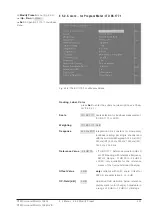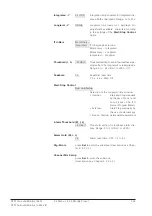
RTW SurroundMonitor 10600
223
RTW SurroundMonitor 10660-VID
E 4.11.1 Background - Calculating Dialnorm Values
Dialnorm has its origins in film sound mixing. The term is an abbreviation of
dialogue normalization. Dialnorm describes the normalization of the
dialogue loudness level with respect to a reference value of 31 dB FS in
surround applications. The idea behind this scheme is that the perceived
total loudness of a mixed audio signal may be determined and kept con-
stant at the listening end by using the dialogue level (optimized for a com-
bination of good intelligibility and minimal nuisance through excessive vo-
lumes) with its fixed loudness ratio in relation to music and sound effects
as a reference. ATSC standard A/52 specifies the transmission of the Dial-
norm parameter as part of the meta data. This Dialnorm value is determined
by means of a method normally used in noise pollution measurement, i. e.
by measuring Leq(A), the energy-equivalent A-weighted sound pressure level
as defined in IEC 60804. Other weigthing filter are possible. Dialnorm makes
use of this standard with the exception that it measures the electrical signal
level with reference to 0 dB FS instead of using the sound pressure level
with a value of 20 µPa as a reference. The Dialnorm value with 0 dB FS as a
reference corresponds to the measured Leq(A) value. The concept uses a
threshold value of 31 dB FS. In the decoder, Dialnorm values above 31
dB FS lead to a level reduction of the total audio signal by (31 dB +
(Dialnorm)) [dB].
Dialnorm has no effect on the dynamics of the overall audio programme or
the loudness ratios of dialog, music, and effects. Only the overall level of
the programme is controlled in relation to a reference value. This overall
level is reduced if the Dialnorm value exceeds this reference value. To this
end, the Dialnorm value is used by the decoder at the receiving end to
control the average overall volume in order to achieve a constant perceived
loudness. This correction operates very smoothly and will not be noticed
by the listener.
E 4 Display Modes E 4.11 Dialnorm Display
Summary of Contents for SurroundMonitor 10600
Page 8: ...RTW SurroundMonitor 10600 8 RTW SurroundMonitor 10660 VID...
Page 10: ...RTW SurroundMonitor 10600 10 RTW SurroundMonitor 10660 VID...
Page 16: ...RTW SurroundMonitor 10600 16 RTW SurroundMonitor 10660 VID...
Page 82: ...RTW SurroundMonitor 10600 82 RTW SurroundMonitor 10660 VID...
Page 136: ...RTW SurroundMonitor 10600 136 RTW SurroundMonitor 10660 VID...
Page 144: ...RTW SurroundMonitor 10600 144 RTW SurroundMonitor 10660 VID...
Page 150: ...RTW SurroundMonitor 10600 150 RTW SurroundMonitor 10660 VID...
Page 152: ...RTW SurroundMonitor 10600 152 RTW SurroundMonitor 10660 VID...
Page 156: ...RTW SurroundMonitor 10600 156 RTW SurroundMonitor 10660 VID...
Page 157: ...SurroundMonitor 10600 10660 VID Be isp iel E xam ple 10 60 0 P LU S Operating Manual english...
Page 158: ...RTW SurroundMonitor 10600 158 RTW SurroundMonitor 10660 VID...
Page 164: ...RTW SurroundMonitor 10600 164 RTW SurroundMonitor 10660 VID...
Page 280: ...RTW SurroundMonitor 10600 280 RTW SurroundMonitor 10660 VID...
Page 288: ...RTW SurroundMonitor 10600 288 RTW SurroundMonitor 10660 VID...
Page 294: ...RTW SurroundMonitor 10600 294 RTW SurroundMonitor 10660 VID...
Page 296: ...RTW SurroundMonitor 10600 296 RTW SurroundMonitor 10660 VID...
Page 300: ...RTW SurroundMonitor 10600 300 RTW SurroundMonitor 10660 VID...
















































